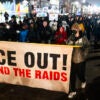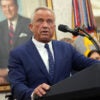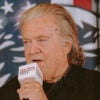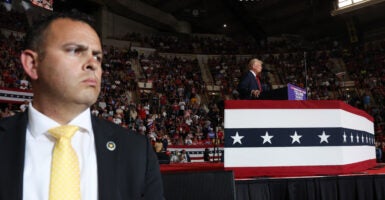Rancor, recriminations, and serious formal misconduct complaints have plagued all levels of the Secret Service detail assigned to protect former President Donald Trump over the past year, distracting the team from its core mission of securing Trump from physical harm and preventing an assassination.
Trump’s regular detail team, a force of 60 employees—special agents and support staff—has been beset by internal division, long workdays and weeks, and constant stress. Last year, the team lost one of its members to suicide.
Among the allegations are accusations of improper sexual relationships or fraternization within the team, debilitating mental health issues, non-merit-based promotions, conflict of interest issues, unfair retaliation, and the creation of inappropriate memes and social media posts.
On May 15, the top two leaders of Trump’s detail sternly dressed down the entire 60-member staff in a virtual meeting, announcing formal investigations into what they argued were serious misconduct violations, several sources in the Secret Service with direct knowledge of the online meeting tell RealClearPolitics.
Sean Curran, the detail leader and top boss of Trump’s regular 60-member protective team, and his deputy, Matthew Piant, complained of “rumors, innuendo, and toxicity” among the detail, as well as “selfishness and immaturity.”
They reminded all employees that they had worked to mentor and train them, and, up to this point, had refrained from referring agents and support employees for discipline even though there had been violations that they could have reported to agency headquarters for investigation.
Curran and Piant complained that they were not getting the same treatment in response from the team. Over the past year, the two leaders have been the target of formal complaints, and some members on the team viewed the all-hands lecture as an effort to turn the tables and retaliate on those complaining about their leadership.
‘Humor and Gossip’
Piant spoke first, accusing someone on the detail of stealing from another. But he quickly shifted to harshly condemning an incident in which a teammate took cellphone photos of two members of the support staff sleeping in a command post while guarding Mar-a-Lago and circulated those to others on the detail.
The No. 2 on the detail deemed the prank a betrayal of the team for the purpose of “humor and gossip,” according to detailed accounts. Those encountering the sleeping individuals should have simply held the team members accountable by waking them up with a nudge, he said.
Piant also argued that taking the photos of individuals who fell asleep and circulating them among the other staff made those team members less safe and endangered the mission. He told the entire team that the pranks and the divisiveness showed a “lack of basic human decency” that had drawn the attention of headquarters “at the highest levels,” according to the sources familiar with the meeting.
He then announced an inspection investigation for potential policy violations and promised consequences for those exercising “bad judgment.”
Yet, some rank-and-file members of the detail team familiar with the sleeping incident said the real outrage was that the individuals who fell asleep while guarding Mar-a-Lago were, to their knowledge, never disciplined. They noted that at least one was the daughter of a retired former Secret Service leader who remained influential among the agency’s top brass.
Sleeping on the job at Mar-a-Lago this spring, the critics said, was especially egregious because of a series of recent security breaches across the Secret Service, including one in which a drunken intruder entered Biden national security adviser Jake Sullivan’s home in the middle of the night. That incident occurred in April 2023 even though Sullivan has a 24/7 Secret Service protective detail because of the high-profile and highly sensitive nature of his job.
Admonishing the Pranksters
Curran spoke after Piant, expressing deep disappointment in the team, echoing the contention that the pranksters had put their teammates’ safety in jeopardy just for a laugh.
Toward the end of the virtual meeting, Curran said he was issuing a final warning to the entire team. Though he didn’t want to alert headquarters to the violations of a handful of people, he said he might have to do so if everyone didn’t start supporting one another.
The detail leader also acknowledged that the team, which has been solely dedicated to protecting Trump from the beginning of his reelection campaign, likely carries more stress than any other division in the Secret Service, and he admonished the pranksters for adding to the tension.
During his remarks, Piant obliquely referred to the team member’s suicide last year, arguing that all members of the team should be especially attuned to mental health problems and risks involved with ridiculing people.
Over the last two weeks, the Secret Service inspections department, which investigates employee misconduct, is homing in on allegations against an agent on the Trump detail who played a key role during the July 13 Butler, Pennsylvania, rally and is partially responsible for developing the security plan, which contained egregious mistakes that left an opening for shooter Thomas Crooks.
An official briefed on the matter, but not authorized to discuss it publicly, told RealClearPolitics that the Secret Service Office of Professional Responsibility also investigated the allegations of sexual impropriety and fraternization within the Trump detail and found the allegations to be “unfounded.”
Agent Under the Microscope
The allegations against the site agent are a separate matter. The agent is now under the microscope not only for her role in devising the security plan for the rally. She’s also facing internal scrutiny for posting videos and photos from her protective assignments to social media. The Secret Service discourages the practice, especially while standing watch on protective duty because it can pinpoint to would-be assailants exactly where the Secret Service positions its assets, risking the protectee and fellow law enforcement agents and officers, according to several sources within the Secret Service community.
The agent in question served as the official site agent for the Butler event that ended in an assassination attempt wounding Trump in the ear and killing rallygoer Corey Comperatore in front of his family. RealClearPolitics is not naming the agent out of concern for her personal safety.
As a member of Trump’s 60-member regular detail, the agent was responsible for helping formulate the security plan for the event, although she was mostly focused on the inner perimeter. She also joined forces with the event’s lead agent, a woman from the Secret Service’s Pittsburgh Field Office, in conducting a walk-through of the security with supervisors. The lead agent typically oversees security at the entire event from airport arrival to event to hotel stay to airport departure.
A RealClearPolitics analysis of the Butler rally site agent’s Facebook account noted a photo that appears to be taken from Mar-a-Lago looking across the intercoastal waterway.
“A sunset to be grateful for …” the post states, including a heart and sunset emojis and the hashtags “#nofilter #southflorida #thankful #workmode …”
Sources familiar with the videos said most appeared on the agent’s Instagram account, which is marked private.
Sources within the Secret Service say the site agent was inexperienced for such a critical security role, but noted that the position is rotated throughout the Trump detail, not routinely assigned based on merit or experience.
Will Site Agent Take the Fall?
There is now concern within the agency that the site agent for the Butler rally will take the fall for the event’s egregious layers of security failures—that acting Secret Service Director Ronald Rowe Jr. will fire her over her social media posts, but not for any security failures at the July 13 event.
In contrast, the lead agent had decades of experience within the Secret Service, but did not have experience on a protective detail, the innermost ring of security for presidents, first ladies, former presidents, and their families, according to sources in the Secret Service community familiar with her background.
While the months of rancor and recriminations leading up to the assassination attempt against Trump undoubtedly distracted the Trump detail from its ultimate mission, the Butler rally served as a wake-up call and a reset, according to sources close to Curran.
“Some agents have referred to it as their 9/11 moment where people are opting back onto the detail,” remarked a source in the Secret Service community. “Morale is high; people are motivated. These agents [protecting Trump] are stiff-jawed with steel in their spine.”
Rowe also plans to address the entire workforce on the Aug. 14 and to be present in Chicago for the Democratic National Committee next week.
While many agents are approaching their protective mission with new vigor, lawmakers are demanding the firing of those responsible for the security failures at Butler. After a month, they say, we still don’t know exactly who was at fault for failing to man the rooftop where Crooks opened fire.
Sources within the Secret Service, however, argue there was plenty of blame to go around that day.
It was the first time countersnipers were assigned to a Trump reelection event, apparently because of an elevated Iranian threat. But Secret Service leaders at headquarters didn’t provide a sniper team for the rooftop where would-be assassin Crooks fired off his shots. Nor did they allocate a countersurveillance unit, roaming agents who work to find and intercept suspicious people or fortify vulnerable areas during a rally.
In addition, supervisors from the Pittsburgh Field Office and the Trump detail were ultimately responsible for evaluating and signing off on the security plan and were thereby integral to ensuring that the plans are sound and all vulnerable areas were covered.
Acting Chief’s Senate Testimony
During Rowe’s July 30 Senate testimony, Sen. Josh Hawley demanded to know the identity of the lead agent for the rally, implying that the person was responsible for the decision to leave the American Glass Research (AGR) building up to local law enforcement to protect. Hawley, however, erred slightly in his questioning, combining the jobs of site agent and lead agent, two separate roles.
Rowe responded that he couldn’t give Hawley that agent’s name because the person was still “operational, still doing investigations, still doing protective visits.” Hawley then demanded to know why Rowe hadn’t fired the person. Rowe explained that the agent is cooperating with the FBI investigation and with the Secret Service’s Office of Professional Responsibility.
“We will let the acts of the mission assurance and any other investigations play out,” Rowe said. He also objected to Hawley’s efforts to “zero in on a particular agent” instead of the “entire decision process” involving multiple individuals responsible for formulating and executing the Secret Service security plan and allocating assets for the rally.
“I want to remain neutral and make sure we get to the bottom of it and interview everybody to determine whether there was more than one person who perhaps exercised bad judgment,” Rowe said.
Both lead agents and site agents are typically involved in walk-throughs with supervisors. The lead agent oversees a whole team of site agents for the airport, the overnight accommodations, and the rally. The lead, considered the point person for the entire trip of a protectee, typically requests the number of post-standers, countersnipers, and other security assets needed for every stop during a visit to a region, including the main event—in this case, the Butler rally.
An additional member of the Pittsburgh team was responsible for working with local law enforcement entities for the plan in the outermost perimeter and likely determined whether local law enforcement needed to be posted on top of or inside the AGR building, from where Crooks fired at Trump and the crowd.
Set Up for Failure?
But these same sources argue that the system that simply rotated the site agent role and didn’t require protective experience for the lead agent set both up for failure. The top supervisors who had to sign off on the security plan for the Butler rally are Tim Burke, special agent in charge of the Secret Service’s Pittsburgh Field Office, and Nick Menster, assistant special agent in charge of the Trump detail.
Burke is a friend of Rowe’s from the time they both served on a counterassault team together early in their careers. Some critics within the Secret Service community question whether their close ties are impacting Rowe’s decision not to fire Burke or anyone else in the Pittsburgh Field Office.
Curran was one of the agents who quickly used their bodies as human shields to protect Trump in the iconic photo of the assassination attempt showing the former president raising his fist, bloody and defiant, against the backdrop of an American flag.
Trump has repeatedly praised the members in that inner security ring, including Curran and a female agent who also appeared in the photo, placing her body across the president’s torso. The woman has been ridiculed on social media by Elon Musk and many others for being too short to fully shield Trump from additional bullets.
“There was great bravery displayed … Every one of them. There wasn’t one that was slow,” Trump told the crowd at a rally in late July. “There was a woman to my right shielding me. A beautiful person. She was shielding me with everything she could.”
Despite the clear bravery of several Secret Service agents and the professionalism of the countersniper who killed Crooks, a month after the assassination attempt, critical questions remain unanswered, including why no one was occupying the AGR rooftop when Crooks opened fire.
Rowe, during Senate testimony July 30, said he could not defend the decision not to have anyone posted on that rooftop, but wouldn’t say who made the decision. Instead, he blamed local law enforcement.
“Why was the assailant not covered when we were told that building was going to be covered?” Rowe angrily demanded during his testimony. “That there had been a face-to-face that afternoon—that our team leads met.”
‘Bizarre’ Break-Ins
Aside from the Butler rally, there has been a string of security lapses or improper activity across the Secret Service as a whole. The latest, which came to light late last week, involved a bizarre July 27 intrusion or break-in of a Pittsfield, Massachusetts, salon, allegedly by the Secret Service covering Vice President Kamala Harris’ first fundraiser.
It’s still unclear whether the Secret Service or local law enforcement is responsible for picking the salon door lock to allow emergency medical services agents and local law enforcement officers, and possibly others, to use the salon’s bathroom.
A woman in what appeared to be Secret Service special agent attire covered the salon’s front-door Ring camera with duct tape, in what knowledgeable sources tell RealClearPolitics is a common practice at event sites to guard against any camera possibly capturing Harris or other protectees in private moments.
The salon owner has said she was left with a messy bathroom and felt violated by the incident. The head of the Boston Field Office called her to apologize for any role the agency played in entering the salon without the owner’s permission.
Several other instances of bizarre behavior and serious security lapses have occurred over the past year and a half.
In late April, Michelle Herczeg, a special agent assigned to Harris’ detail had an apparent mental breakdown at Joint Base Andrews, home to Air Force One and Air Force Two. RealClearPolitics has since learned that former Secret Service Director Kimberly Cheatle, who chaired the Rowley Training Center when Herczeg was training there, passed her even though Herczeg failed to meet some critical standards and some fellow workers expressed concern about her mental fitness, according to four sources within the Secret Service community.
Cheatle, who resigned amid bipartisan furor after her July testimony about the Butler rally security lapses, was reportedly “livid” over the Sullivan security failure in May 2023. The agency chalked up the security lapse to “human failure” or inattention among agents guarding Sullivan’s home. Luckily for Sullivan, the intruder appeared to be an intoxicated neighbor who simply entered the wrong home. There were no signs of forced entry into Sullivan’s home, but the agents stationed outside also did not detect the intruder, with whom Sullivan had a brief physical encounter.
Intrusion at Obama’s Hawaii Home
Over the past year, there have been at least two other previously undisclosed intrusions, some that have been reported, but two that have not. One involved a breach at former President Barack Obama’s Hawaii residence, and another involved a strange intruder stay at the Miami Field Office this spring.
In the Obamas’ residence intrusion, the Secret Service managed to locate the intruders. Two sources described those who managed to breach the waterfront compound’s cutting-edge security as young people trying to get photos of the residence and its impressive grounds to post on social media. The property previously served as the set for the popular law enforcement drama television series “Magnum P.I.” in the 1980s and in a more recent remake.
The former president and first lady were not home during the time, but sources said their two daughters were on the premises.
(The Obamas’ friend Marty Nesbitt, a wealthy Chicago businessman, purchased the three-acre property on Oahu, paying $8.7 million in 2015. As of at least the spring of 2018, the property was held in an LLC registered to Nesbitt, who serves as chairman of the Barack Obama Foundation. That same year, the owners tore down the dated 9,000-square-foot residence, known on the television series as “Robin’s Nest,” according to Honolulu magazine. In its place, Nesbitt, with the Obamas’ input, built three custom structures on the compound, including a state-of-the-art security system and two swimming pools.)
In late May of this year, an erratic man was able to infiltrate and spend at least one night in the Miami Field Office, according to four sources familiar with the incident.
Some agents working out in the gym violated office policy by propping open the door to help ventilate the room. A man in shorts and a T-shirt entered through that partially opened door, and no one noticed. The man, identified as Ashtyn Domenech by one knowledgeable source, apparently found the “bunk room,” took a shower, and fell asleep in a bed overnight, sources said.
Domenech accessed computers on an open internet line and downloaded and watched porn, according to two sources familiar with the trespassing incident.
The next morning, Domenech asked administration staff where he “could get a cup of coffee around here,” and the employees responded by fulfilling his request for coffee without realizing he didn’t belong there, the sources said. He then ventured into a class on defensive tactics that a supervisor was teaching. The supervisor confronted him about his identity and apprehended him.
The Secret Service didn’t arrest Domenech on federal charges, but instead turned him over to the local Miami Beach Police Department, which charged him with burglary, petty theft, and unlawful use of a police badge. Domenech had been arrested earlier that month for indecent exposure, according to Miami court records.
Originally published by RealClearPolitics and made available via RealClearWire.





























